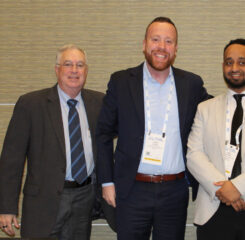How COVID-19 and Technology Would Reshape our Future
The recent COVID-19 pandemic, which disproportionately impacted the older, frailer, and other vulnerable populations that LeadingAge members across the nation care for, has had a significant impact on aging services providers, caregivers, families, our strained healthcare systems, the economy, and even the environment across the globe.
While most of the impacts we’ve been seeing were negative, even catastrophic, we have witnessed some needed and long-awaited changes that have been accelerated as a byproduct of our response to this global pandemic. Some of these changes, especially with respect to the use of technology, would most likely reshape our future. Let’s reflect on some of the longer-term changes that are likely to remain in place, and their implications on aging services and potentially other sectors.
Internet Connectivity
In response to the shut-down of business offices, telework policies business rushed to put in place, social distancing, quarantine, no visitation, and limited socialization opportunities, internet connectivity, all of a sudden, became the most efficient and safest way to have meetings, conduct business, and keep some parts of the economy running!
Of course, that was not a stretch for most companies in the information and technology economy sectors; I, for one have been telecommuting most days of the week for almost 14 years! But during this pandemic, even the most anti-telework/ telecommuting sectors and corporations found themselves having to embrace this option to keep some wheels turning.
Many businesses have had to move software to the cloud and adopt video conferencing, virtualization, virtual private networks (VPNs) to provide employees with secure access to files, two-factor authentication, and significantly ramp-up remote support capabilities for their staff and clients!
Social Connectedness and Engagement Technologies
Over the past couple of years, we have witnessed an explosion of more intuitive easy-to-use social connectedness and engagement technologies, including voice-controlled devices and user interfaces. These technologies were already gaining popularity among consumers, including older adults, and were adopted by nearly half of the larger aging services providers in the United States, even before the COVID-19 pandemic.
Since the pandemic, we’ve noticed a significant increase in interest from aging services providers, caregivers, consumers, and others in these technologies to compensate for sheltering in place, prohibition of visitations, and quarantine conditions to keep older adults who were cut off from their friends and families connected and engaged.
In response to the increased interest, LeadingAge CAST produced a QuickCast on the topic to complement our Social Connectedness and Engagement Portfolio of Tools.
Telehealth
LeadingAge and CAST have always believed in the benefits and value of telehealth, especially for older adults who are known to have multiple chronic conditions, regardless of the care setting, geography, or modality of telehealth!
During the pandemic, telehealth emerged as a viable option to safely access many healthcare services, from a quick virtual visit with the doctor, to a teleconsultation with a specialist, to chronic disease management at home, to even remote emergency triage of individuals to eliminate unnecessary exposure to COVID-19 in an overwhelmed ER or a hospital!
With a blanket emergency use waiver, the Centers for Medicare & Medicaid Services (CMS) removed many of the geographic, originating site, telehealth modality and type of service restrictions.
To help explain the flexibilities, we produced a QuickCast providing an overview of the flexibilities most relevant to aging services providers and the older adults we serve, highlighting a unique funding opportunity, and giving providers setting-specific advice. Those interested in selecting and implementing telehealth would find our Telehealth and Remote Patient Monitoring Portfolio of tools extremely helpful.
Online Learning / Training
Another area where technology and the use of the internet has soared is of course online learning/ training where many universities, schools, associations, and other educational institutions have doubled down on shoring up their online learning management systems, course offerings, and operations, including offering virtual events, like conferences and expos!
Implications Beyond the Current Pandemic
In a very short time span, the pandemic has shown us that telecommuting, telehealth, and distance learning are all viable, efficient, and cost-effective options. That not all travel is as essential, as we used to believe!
It has taught us that we can adapt…and that such adaptation can have some positive side effects; just look at how reducing travel positively impacted the environment! We’ve also come to realize that the internet is an essential utility, just like water, sewer, and electricity, and that connectivity should be a right for all citizens this day and age, regardless of socio-economic status! Finally, we’ve come to realize that expensive commercial real estate in downtown major cities is over-rated and that we should reconsider our previous approaches to urban planning, including parking spaces.
Moving forward, I believe that we will see businesses more broadly accepting of telework wherever possible in our society, and will consequently experience less travel, congestion, and pollution. We are likely to see more and more online learning, training, and virtual events.
I firmly believe that the telehealth genie is out of the bottle and won’t be returning to the previous constrictive position it was in before this pandemic! However, businesses, including aging service providers, need to invest in improving their remote work and tele-X capabilities from the IT infrastructure from redundant connectivity, to back-up and recovery, security, and remote support. Moreover, as a country, we will need to invest in our telecommunications infrastructure to ensure that it is not only available ubiquitously, and capable of handling the demand, but also future-proofed, secure, and affordable to all citizens!
What Are You Seeing?
What changes have you been seeing since the pandemic began? Please share your observations and experiences with CAST, so that we can better understand how aging services providers are being affected. Please send me an email at MAlwan@LeadingAge.org.
To learn more about predicted changes in telehealth, see “Telehealth May Be Here to Stay” in this month’s edition of Tech Time.
*
A version of this article will appear in LeadingAge California’s Engage Magazine.

Most Recommended
October 15, 2025
 Shutdown Week Three: Impact of Ongoing Closure on Affordable Housing
Shutdown Week Three: Impact of Ongoing Closure on Affordable Housing
December 10, 2025
Fiscal Year (FY) Funding 2026
October 07, 2025
Immigrant Workforce Matching Program Brings Workforce Relief
Recently Added
December 17, 2025
 Colleagues on the Move, December 17, 2025
Colleagues on the Move, December 17, 2025
December 16, 2025



